Experimental and Theoretical Estimations of Atrazine’s Adsorption in Mangosteen-Peel-Derived Nanoporous Carbons
Abstract
1. Introduction
2. Results and Discussion
2.1. N2 Adsorption–Desorption Isotherms
2.2. Scanning Electron Microscopy (SEM) and Surface Analysis
2.3. Atrazine Adsorption
2.3.1. Kinetic Studies
2.3.2. Adsorption Isotherms of Atrazine
2.4. General Discussion and Theoretical Estimations
3. Experimental Procedures
3.1. Synthesis of Nanoporous Biochars
3.2. Characterization
3.3. Kinetics and Equilibrium Studies of the Atrazine Adsorption
3.4. Theoretical Estimations
4. Conclusions
Supplementary Materials
Author Contributions
Funding
Institutional Review Board Statement
Informed Consent Statement
Data Availability Statement
Conflicts of Interest
Sample Availability
Ethical Approval
References
- Ratnayaka, D.D.; Brandt, M.J.; Johnson, K.M. Specialized and advanced water treatment processes. In Water Supply, 6th ed.; Ratnayaka, D., Brandt, M.J., Johnson, K.M., Eds.; Elsevier: Amsterdam, The Netherlands, 2009; pp. 365–423. [Google Scholar]
- Crittenden, J.C.; Trussell, R.R.; Hand, D.W.; Howe, K.J.; Tchobanoglous, G. Granular filtration. In MWH’s Water Treatment: Principles and Design; John and Wiley and Sons: Hoboken, NJ, USA, 2012; pp. 727–818. [Google Scholar]
- Sauvé, S.; Desrosiers, M. A review of what is an emerging contaminant. Chem. Cent. J. 2014, 8, 15. [Google Scholar] [CrossRef]
- Ternes, T.A.; Meisenheimer, M.; McDowell, D.; Sacher, F.; Brauch, H.-J.; Haistgulde, B.; Zulei-Seibert, N. Removal of pharmaceuticals during drinking water treatment. Environ. Sci. Technol. 2002, 36, 3855–3863. [Google Scholar] [CrossRef] [PubMed]
- Loraine, G.A.; Pettigrove, M.E. Seasonal variations in concentrations of pharmaceuticals and personal care products in drinking water and reclaimed wastewater in southern California. Environ. Sci. Technol. 2006, 40, 687–695. [Google Scholar] [CrossRef] [PubMed]
- Gibs, J.; Stackelberg, P.E.; Furlong, E.T.; Meyer, M.; Zaugg, S.D.; Lippincott, R.L. Persistence of pharmaceuticals and other organic compounds in chlorinated drinking water as a function of time. Sci. Total Environ. 2007, 373, 240–249. [Google Scholar] [CrossRef] [PubMed]
- Stackelberg, P.E.; Gibs, J.; Furlong, E.T.; Meyer, M.; Zaugg, S.D.; Lippincott, R. Efficiency of conventional drinking-water-treatment processes in removal of pharmaceuticals and other organic compounds. Sci. Total Environ. 2007, 377, 255–272. [Google Scholar] [CrossRef]
- Syafrudin, M.; Kristanti, R.A.; Yuniarto, A.; Hadibarata, T.; Rhee, J.; Al-Onazi, W.A.; Algarni, T.S.; Almarri, A.H.; Al-Mohaimeed, A.M. Pesticides in drinking water—A review. Int. J. Environ. Res. Public Health 2021, 18, 468. [Google Scholar] [CrossRef] [PubMed]
- Buchanan, I.; Liang, H.C.; Khan, W.; Liu, Z.; Singh, R.; Ikehata, K.; Chelme-Ayala, P. Pesticides and Herbicides. Water Environ. Res. 2009, 81, 1731–1815. [Google Scholar] [CrossRef]
- Agency for Toxic Substances and Disease Registry (ATSDR). ATRAZINE, CAS # 1912-24-9; ATSDR: Atlanta, GA, USA, September 2003. [Google Scholar]
- Errata/Addendum Sheet for Changes to the Atrazine Interim Reregistration Eligibility Decision; United States Environmental Protection Agency (USEPA): Washington, DC, USA, 2003. Available online: https://www3.epa.gov/pesticides/chem_search/reg_actions/reregistration/ired_PC-080803_1-Jan-03.pdf (accessed on 1 May 2023).
- James, T.K.; Ghanizadeh, H.; Harrington, K.C.; Bolan, N.S. Degradation of atrazine and bromacil in two forestry waste products. Sci. Rep. 2021, 11, 3284. [Google Scholar] [CrossRef]
- Graymore, M.; Stagnitti, F.; Allinson, G. Impacts of atrazine in aquatic ecosystems. Environ. Int. 2001, 26, 483–495. [Google Scholar] [CrossRef]
- Mudhoo, A.; Garg, V.K. Sorption, Transport and transformation of atrazine in soils, minerals and composts: A review. Pedosphere 2011, 21, 11–25. [Google Scholar] [CrossRef]
- Nödler, K.; Licha, T.; Voutsa, D. Twenty years later—Atrazine concentrations in selected coastal waters of the Mediterranean and the Baltic Sea. Mar. Pollut. Bull. 2013, 70, 112–118. [Google Scholar] [CrossRef] [PubMed]
- Singh, S.; Kumar, V.; Chauhan, A.; Datta, S.; Wani, A.B.; Singh, N.; Singh, J. Toxicity, degradation and analysis of the herbicide atrazine. Environ. Chem. Lett. 2018, 16, 211–237. [Google Scholar] [CrossRef]
- Spanò, L.; Tyler, C.C.R.; van Aerle, R.; Devos, P.; Mandiki, S.N.; Silvestre, F.; Thomé, J.P.; Kestemont, P. Effects of atrazine on sex steroid dynamics, plasma vitellogenin concentration and gonad development in adult goldfish (Carassius auratus). Aquat. Toxicol. 2004, 66, 369–379. [Google Scholar] [CrossRef]
- Hayes, T.B.; Collins, A.; Lee, M.; Mendoza, M.; Noriega, N.; Stuart, A.; Vonk, A. Hermaphroditic, demasculinized frogs after exposure to the herbicide atrazine at low ecologically relevant doses. Proc. Natl. Acad. Sci. USA 2002, 99, 5476–5480. [Google Scholar] [CrossRef] [PubMed]
- Albuquerque, F.P.; de Oliveira, J.L.; Moschini-Carlos, V.; Fraceto, L.F. An overview of the potential impacts of atrazine in aquatic environments: Perspectives for tailored solutions based on nanotechnology. Sci. Total Environ. 2019, 700, 134868. [Google Scholar] [CrossRef]
- Fan, W.; Yanase, T.; Morinaga, H.; Gondo, S.; Okabe, T.; Nomura, M.; Komatsu, T.; Morohashi, K.; Hayes, T.B.; Takayanagi, R.; et al. Atrazine-induced aromatase expression is SF-1 dependent: Implications for endocrine disruption in wildlife and reproductive cancers in humans. Env. Health Perspect. 2017, 115, 720. [Google Scholar] [CrossRef]
- Rinsky, J.L.; Hopenhayn, C.; Golla, V.; Browning, S.; Bush, H. Atrazine exposure in public drinking water and preterm birth. Public Health Rep. 2012, 127, 72–80. [Google Scholar] [CrossRef] [PubMed]
- Almberg, K.S.; Turyk, M.E.; Jones, R.M.; Rankin, K.; Freels, S.; Stayner, L.T. Atrazine contamination of drinking water and adverse birth outcomes in community water systems with elevated atrazine in Ohio, 2006–2008. Int. J. Environ. Res. Public Health 2018, 15, 1889. [Google Scholar] [CrossRef]
- Galbiati, V.; Buoso, E.B.; d’Emmanuele di Villa Bianca, R.D.; Paola, F.; Morroni, G.; Nocentini, M.; Racchi, B.; Viviani, E. Corsini, Immune and nervous systems interaction in endocrine disruptors toxicity: The case of atrazine. Front. Toxicol. 2021, 3, 649024. [Google Scholar] [CrossRef]
- Commission Decision Concerning the Non-Inclusion of Atrazine in Annex I to Council Directive 91/414/EEC and the Withdrawal of Authorizations for Plant Protection Products Containing This Active Substance. Off. J. Eur. Union 2004, 3, 157. Available online: https://eur-lex.europa.eu/legal-content/EN/TXT/PDF/?uri=CELEX:52020SC0087&rid=1 (accessed on 1 May 2023).
- Directive 2000/60/EC of the European Parliament and of the Council of 23 October 2000 Establishing a Framework for Community Action in the Field of Water Policy. Off. J. Eur. Communities 2000, L327, 72. Available online: https://www.eea.europa.eu/policy-documents/directive-2000-60-ec-of (accessed on 1 May 2023).
- PAN International. The Consolidated List of Banned Pesticides, 6th ed.; Pesticide Action Network International: Penang, Malaysia, 2022; Available online: https://pan-international.org/pan-international-consolidated-list-of-banned-pesticides/ (accessed on 1 May 2023).
- World Health Organization (WHO). Guidelines for Drinking Water Quality. 2011. Available online: http://whqlibdoc.who.int/publications/2011/9789241548151_eng.pdf (accessed on 1 May 2023).
- Villanueva, C.M.; Durand, G.; Coutté, M.B.; Chevrier, C.; Cordier, S. Atrazine in municipal drinking water and risk of low birth weight, preterm delivery, and small-for-gestational-age status. Occup. Environ. Med. 2005, 62, 400–405. [Google Scholar] [CrossRef] [PubMed]
- Hildebrandt, A.; Guillamon, M.; Lacorte, S.; Tauler, R.; Barcelo, D. Impact of pesticides used in agriculture and vineyards to surface and groundwater quality (NorthSpain). Water Res. 2008, 42, 3315–3326. [Google Scholar] [CrossRef] [PubMed]
- Bohn, T.; Cocco, E.; Gourdol, L.; Guignard, C.; Hoffmann, L. Determination of atrazine and degradation products in Luxembourgish drinking water: Origin and fate of potential endocrine disrupting pesticides. Food Addit. Contam. 2011, 28, 1041–1054. [Google Scholar] [CrossRef]
- Gómez-Gutiérrez, A.I.; Jover, E.; Bodineau, L.; Albaigés, J.; Bayona, J.M. Organic contaminant loads into the Western Mediterranean Sea: Estimate of Ebro river inputs. Chemosphere 2006, 65, 224–236. [Google Scholar] [CrossRef]
- Carafa, R.; Wollgast, J.; Canuti, E.; Ligthart, J.; Dueri, S.; Hanke, G.; Eisenreich, S.J.; Viaroli, P.; Zaldívar, J.M. Seasonal variations of selected herbicides and related metabolites in water, sediment, seaweed and clams in the Sacca di Goro coastal lagoon (Northern Adriatic). Chemosphere 2007, 69, 1625–1637. [Google Scholar] [CrossRef]
- De Ambiente, M.; Vivienda y Desarrollo Territorial. Resolución. 2017. Available online: https://www.minsalud.gov.co/sites/rid/Lists/BibliotecaDigital/RIDE/DE/DIJ/Resoluci%C3%B3n_2115_de_2007.pdf (accessed on 1 May 2023).
- United Nations Environment Program (UNEP). Central America, and the Caribbean Regional Report. Regionally Based Assessment of Persistent Toxic Substances. 2002. Available online: http://www.oas.org/dsd/Quimicos/Central%20America%20Caribbean%20Report%20UNEP.pdf (accessed on 1 May 2023).
- Hernandez-Antonio, A. Modelo Conceptual de Contaminación de Aguas Superficiales Por Uso de Atrazina en Zonas Agrícolas. Ph.D. Thesis, Universidad Nacional Autónoma de México, Morelos, Mexico, 2013. Available online: https://repositorio.unam.mx/contenidos/modelo-conceptual-de-contaminacion-de-aguas-superficiales-por-uso-de-atrazina-en-zonas-agricolas-74101?c=r1gbgE&d=false&q=*:*&i=2&v=1&t=search_0&as=0 (accessed on 1 May 2023).
- Ormad, M.P.; Miguel, N.; Claver, A.; Matesanz, J.M.; Ovelleiro, J.L. Pesticides removal in the process of drinking water production. Chemosphere 2008, 71, 97–106. [Google Scholar] [CrossRef]
- Ignatowicz, K. Selection of sorbent for removing pesticides during water treatment. J. Hazard. Mater. 2009, 169, 953–957. [Google Scholar] [CrossRef]
- Chen, Y.; Huang, B.; Huang, M.; Cai, B. On the preparation and characterization of activated carbon from mangosteen shell. J. Taiwan Inst. Chem. Eng. 2011, 42, 837–842. [Google Scholar] [CrossRef]
- Yusufu, M.I.; Ariahu, C.C.; Igbabul, B.D. Production and characterization of activated carbon from selected local raw materials. Afr. J. Pure Appl. Chem. 2012, 6, 123–131. [Google Scholar] [CrossRef]
- Gupta, V.K.; Ali, I. Water treatment for organic pollutants by adsorption technology. In Environmental Water: Advances in Treatment, Remediation and Recycling; Gupta, V.K., Ali, I., Eds.; Elsevier: Amsterdam, The Netherlands, 2013; pp. 29–91. [Google Scholar]
- Yahya, M.A.; Al-Qodah, Z.; Ngah, C.W.Z. Agricultural bio-waste materials as potential sustainable precursors used for activated carbon production: A review. Renew. Sustain. Energy Rev. 2015, 46, 218–235. [Google Scholar] [CrossRef]
- Lupul, I.; Yperman, J.; Carleer, R.; Gryglewicz, G. Adsorption of atrazine on hemp stem-based activated carbons with different surface chemistry. Adsorption 2015, 21, 489–498. [Google Scholar] [CrossRef]
- Li, Y.; Wang, X.; Cao, M. Three-dimensional porous carbon frameworks derived from mangosteen peel waste as promising materials for CO2 capture and supercapacitors. J. CO2 Util. 2018, 27, 204–216. [Google Scholar] [CrossRef]
- Dasgupta, A.; Matos, J.; Muramatsu, H.; Ono, Y.; González, V.; Liu, H.; Rotella, C.; Fujizawa, K.; Cruz-Silva, R.; Hashimoto, Y.; et al. Nanostructured carbon materials for enhanced nitrobenzene adsorption: Physical vs. Chemical surface properties. Carbon 2018, 139, 833–844. [Google Scholar] [CrossRef]
- Amézquita-Marroquín, C.P.; Torres-Lozada, P.; Giraldo, L.; Húmpola, P.D.; Rivero, E.; Poon, P.S.; Matos, J.; Moreno-Piraján, J.C. Sustainable production of nanoporous carbons: Kinetics and equilibrium studies in the removal of atrazine. J. Coll. Inter. Science. 2020, 562, 252–267. [Google Scholar] [CrossRef]
- Rouquerol, J.; Llewellyn, P.; Rouquerol, F. Characterization of porous solids VII. Stud. Surf. Sci. Catal. 2007, 160, 49–56. [Google Scholar]
- Thommes, M.; Cychosz, K.A. Physical adsorption characterization of nanoporous materials: Progress and challenges. Adsorption 2014, 20, 233–250. [Google Scholar] [CrossRef]
- Dubinin, M.M. Description of adsorption equilibria of vapors on zeolites over wide ranges of temperature and pressure. Adv. Chem. Ser. 1971, 102, 69–85. [Google Scholar]
- Matos, J.; Laine, J. Ethylene Conversion on Activated Carbon Supported NiMo Catalysts: Effect of the Support. Appl. Catal. A Gen. 2003, 241, 25–38. [Google Scholar] [CrossRef]
- Matos, J.; Labady, M.; Albornoz, A.; Laine, J.; Brito, J.L. Topological organization and textural changes of carbon macro-networks submitted to activation with N2 and CO2. J. Mater. Sci. 2004, 39, 3705–3716. [Google Scholar] [CrossRef]
- Matos, J.; Labady, M.; Albornoz, A.; Laine, J.; Brito, J.L. Catalytic Effect of KOH on textural changes of carbon macronetworks by physical activation. J. Molec. Catal. A Chem. 2005, 228, 189–194. [Google Scholar] [CrossRef]
- Alves, L.A.; de Castro, A.H.; de Mendonça, F.G.; de Mesquita, J.P. Characterization of acid functional groups of carbon dots by nonlinear regression data fitting of potentiometric titration curves. Appl. Surf. Sci. 2016, 370, 486–495. [Google Scholar] [CrossRef]
- Matos, J.; Arcibar-Orozco, J.; Poon, P.S.; Pecchi, G.; Rangel-Mendez, J.R. Influence of phosphorous upon the formation of DMPO-•OH and POBN-O2•¯ spin-trapping adducts in carbon-supported P-promoted Fe-based photocatalysts. J. Photochem. Photobiol. A Chem. 2020, 391, 112362. [Google Scholar] [CrossRef]
- Wu, F.-C.; Tseng, R.-L.; Juang, R.-S. Initial behavior of intraparticle diffusion model used in the description of adsorption kinetics. Chem. Eng. J. 2009, 153, 1–8. [Google Scholar] [CrossRef]
- McKay, G.; Otterburn, M.S.; Sweeney, A.G. The removal of color from effluent using various adsorbents—III. Silica: Rate processes. Water Res. 1980, 14, 15–20. [Google Scholar] [CrossRef]
- Ho, Y.S.; McKay, G. A Comparison of Chemisorption Kinetic Models Applied to Pollutant Removal on Various Sorbents. Process Saf. Environ. Prot. 1998, 76, 332–340. [Google Scholar] [CrossRef]
- Wu, F.-C.; Tseng, R.-L.; Juang, R.-S. Kinetic modeling of liquid-phase adsorption of reactive dyes and metal ions on chitosan. Water Res. 2001, 35, 613–618. [Google Scholar] [CrossRef]
- Lagergren, S. Zur Theorie Der Sogenannten Adsorption Geloster Stoffe. K. Sven. Vetenskapsakademiens Handl. 1898, 24, 1–39. [Google Scholar]
- Ho, Y.; McKay, G. Pseudo-second order model for sorption processes. Process Biochem. 1999, 34, 451–465. [Google Scholar] [CrossRef]
- Tan, G.; Sun, W.; Xu, Y.; Wang, H.; Xu, N. Sorption of mercury (II) and atrazine by biochar, modified biochars and biochar based activated carbon in aqueous solution. Bioresour. Technol. 2016, 211, 727–735. [Google Scholar] [CrossRef]
- Leyva-Ramos, R.; Ocampo-Perez, R.; Mendoza-Barrón, J. External mass transfer and hindered diffusion of organic compounds in the adsorption on activated carbon cloth. Chem. Eng. J. 2012, 183, 141–151. [Google Scholar] [CrossRef]
- Langmuir, I. The constitution and fundamental properties of solids and liquids. Part I Solids. J. Am. Chem. Soc. 1916, 38, 2221–2295. [Google Scholar] [CrossRef]
- Freundlich, H. Über die adsorption in Lösungen. Z. Phys. Chem. Stöchiometrie Verwandschaftslehre 1907, 57, 385–470. [Google Scholar] [CrossRef]
- Matos, J.; Fierro, V.; Montaña, R.; Rivero, E.; de Yuso, A.M.; Zhao, W.; Celzard, A. High surface area microporous carbons as photoreactors for the catalytic photodegradation of methylene blue under UV-vis irradiation. Appl. Catal. A Gen. 2016, 517, 1–11. [Google Scholar] [CrossRef]
- Matos, J.; Ocares-Riquelme, J.; Poon, P.S.; Montaña, R.; García, X.; Campos, K.; Hernández-Garrido, J.C.; Titirici, M.M. C-doped anatase TiO2: Adsorption kinetics and photocatalytic degradation of methylene blue and phenol, and correlations with DFT estimations. J. Colloid Inter. Sci. 2019, 547, 14–29. [Google Scholar] [CrossRef] [PubMed]
- Borisover, M.D.; Graber, E.R. Comment on competitive sorption between atrazine and other organic compounds in soils and model sorbents. Environ. Sci. Technol. 1997, 31, 1577. [Google Scholar] [CrossRef]
- Perdew, J.P.; Burke, K.; Ernzerhof, M. Generalized gradient approximation made simple. Phys. Rev. Lett. 1997, 78, 1396. [Google Scholar] [CrossRef]
- Wang, W.; Zhang, Y.; Shen, C.; Chai, Y. Adsorption of CO molecules on doped graphene: A first-principles study. AIP Adv. 2016, 6, 025317. [Google Scholar] [CrossRef]
- Bagri, A.; Grantab, R.; Medhekar, N.V.; Shenoy, V.B. Stability and Formation Mechanisms of Carbonyl- and Hydroxyl-Decorated Holes in Graphene Oxide. J. Phys. Chem. C 2010, 114, 12053–12061. [Google Scholar] [CrossRef]
- Boehm, H.P. Surface oxides on carbon and their analysis: A critical assessment. Carbon 2002, 40, 145–149. [Google Scholar] [CrossRef]
- De Cordoba, M.C.F.; Matos, J.; Montaña, R.; Poon, P.S.; Lanfredi, S.; Praxedes, F.R.; Hernández-Garrido, J.C.; Calvino, J.J.; Rodríguez-Aguado, E.; Rodríguez-Castellón, E.; et al. Sunlight photoactivity of rice husks-derived biogenic silica. Catal. Today 2019, 328, 125–135. [Google Scholar] [CrossRef]
- Giannozzi, P.; Baroni, S.; Bonini, N.; Calandra, M.; Car, R.; Cavazzoni, C.; Ceresoli, D.; Chiarotti, G.L.; Cococcioni, M.; Dabo, I.; et al. Quantum Espresso: A modular and open-source software project for quantum simulations of materials. J. Phys. Condens. Matter 2009, 21, 395502. [Google Scholar] [CrossRef] [PubMed]
- Available online: http://pseudopotentials.quantum-espresso.org/legacy_tables/ps-library/o (accessed on 1 May 2023).
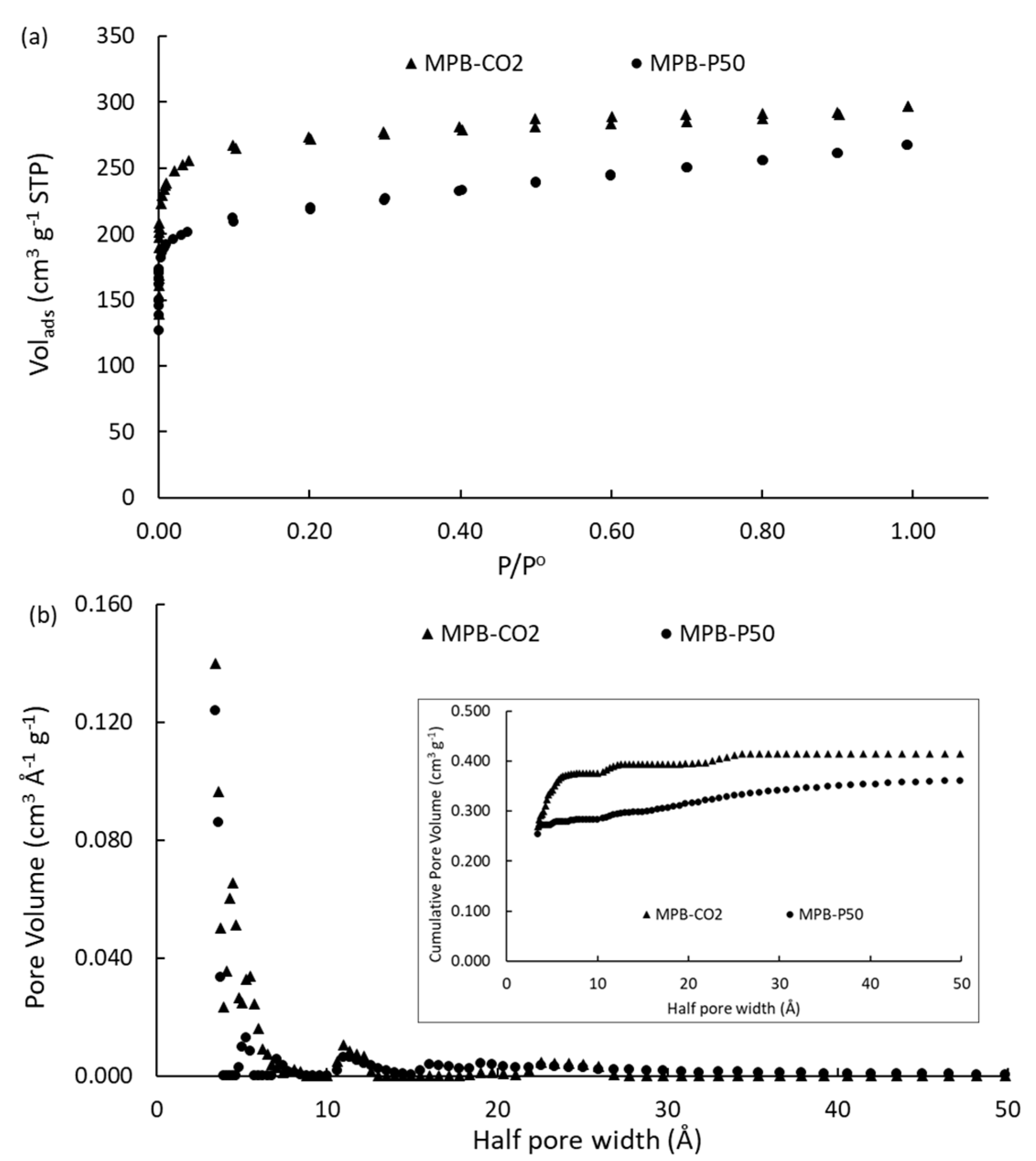
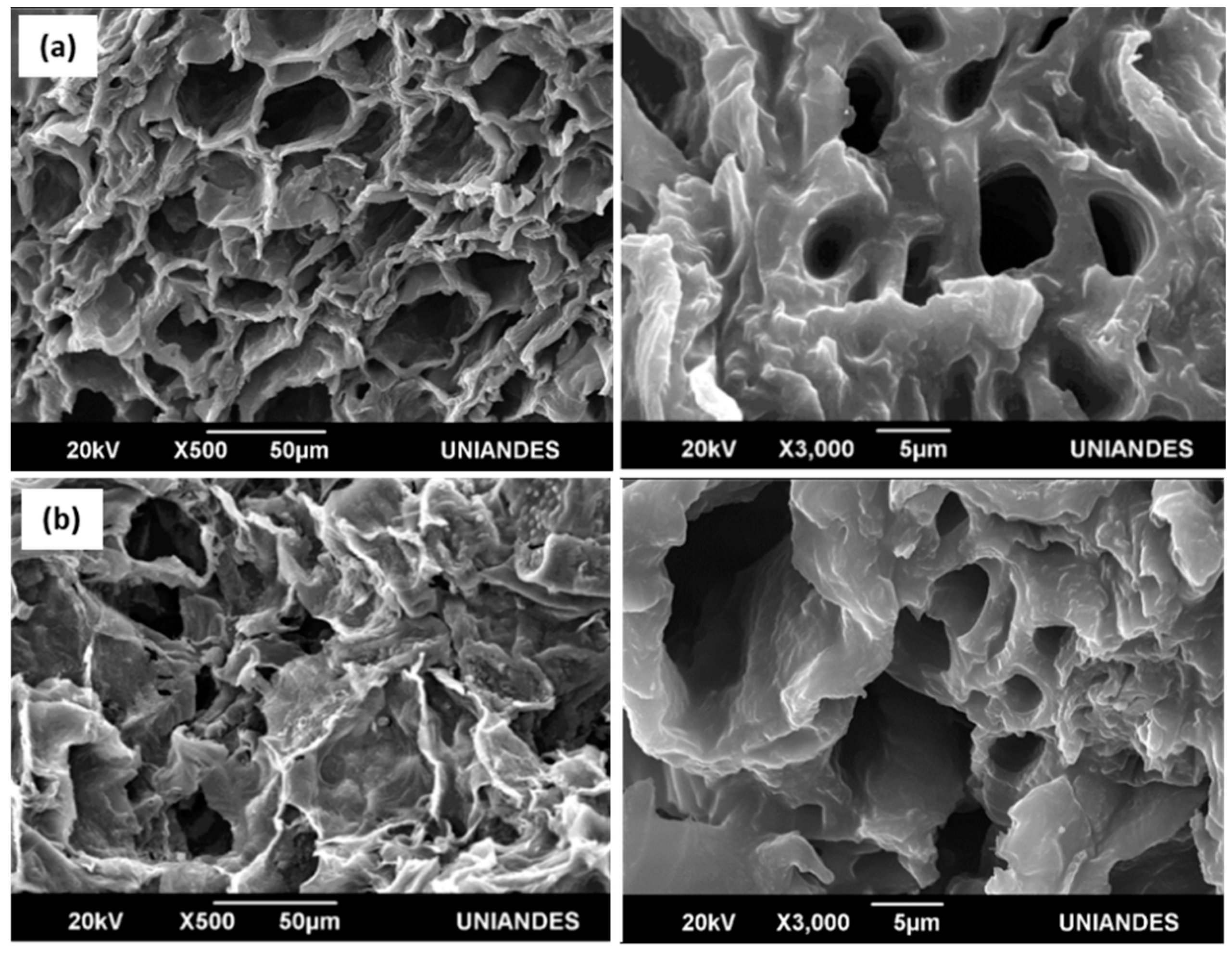
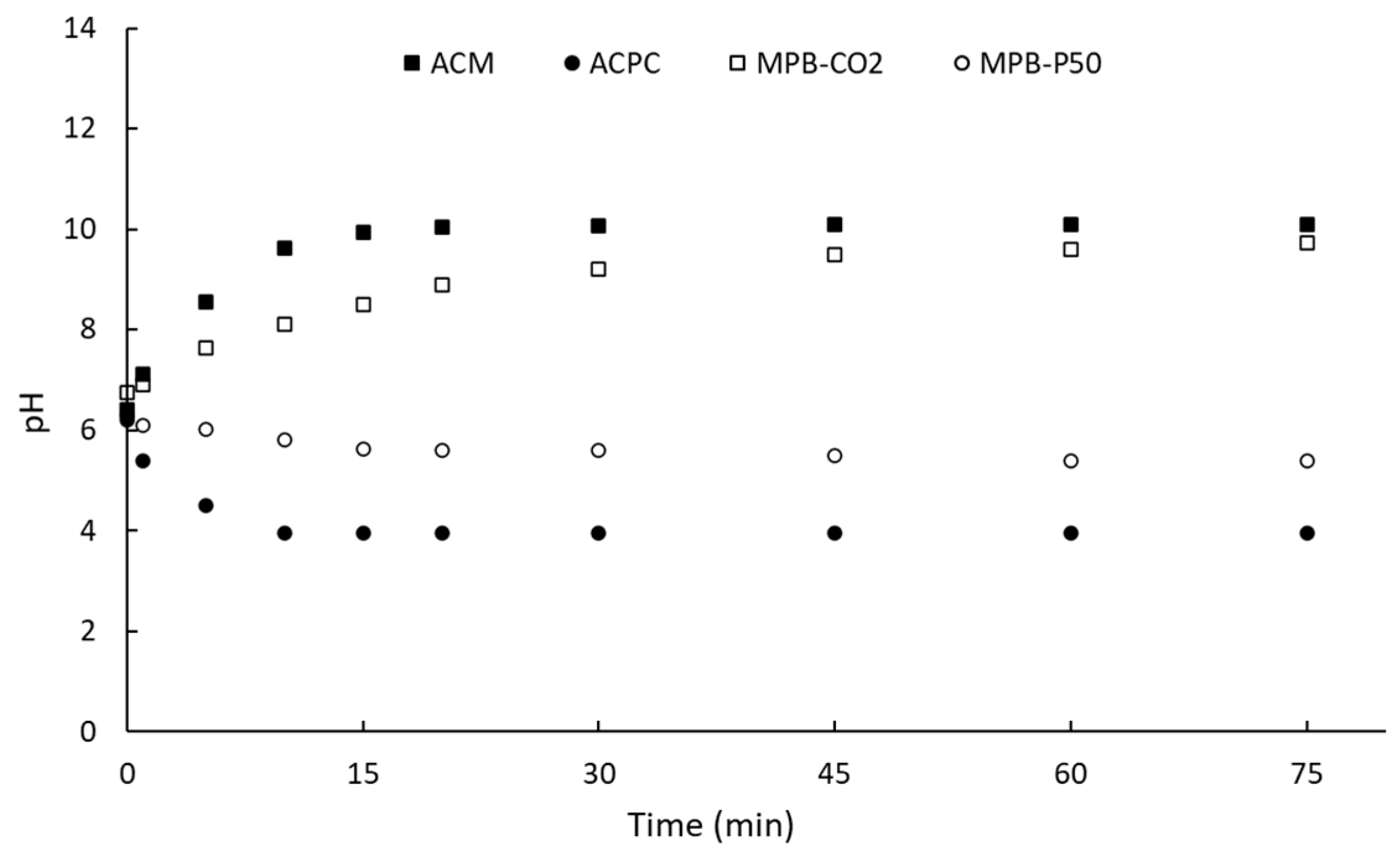
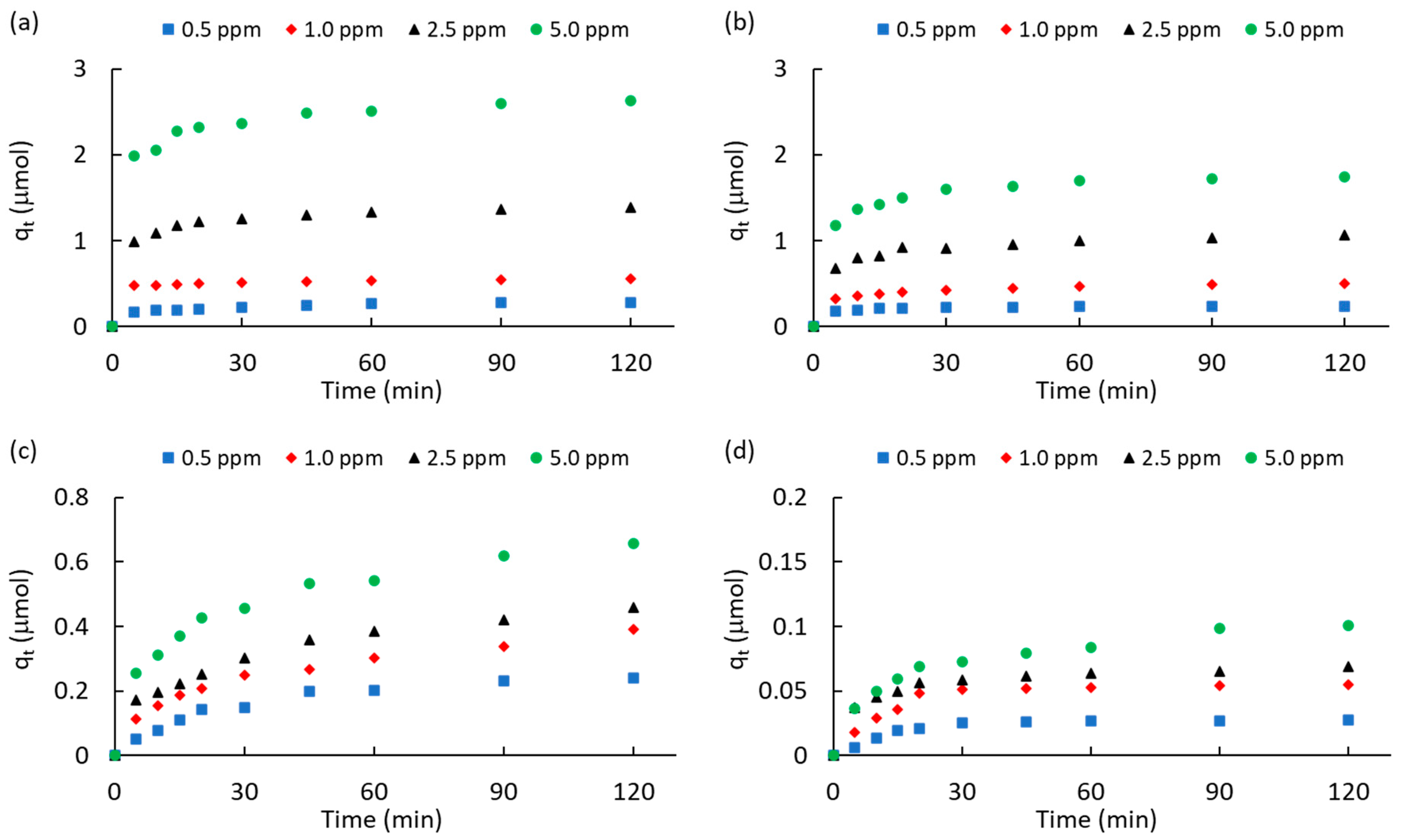
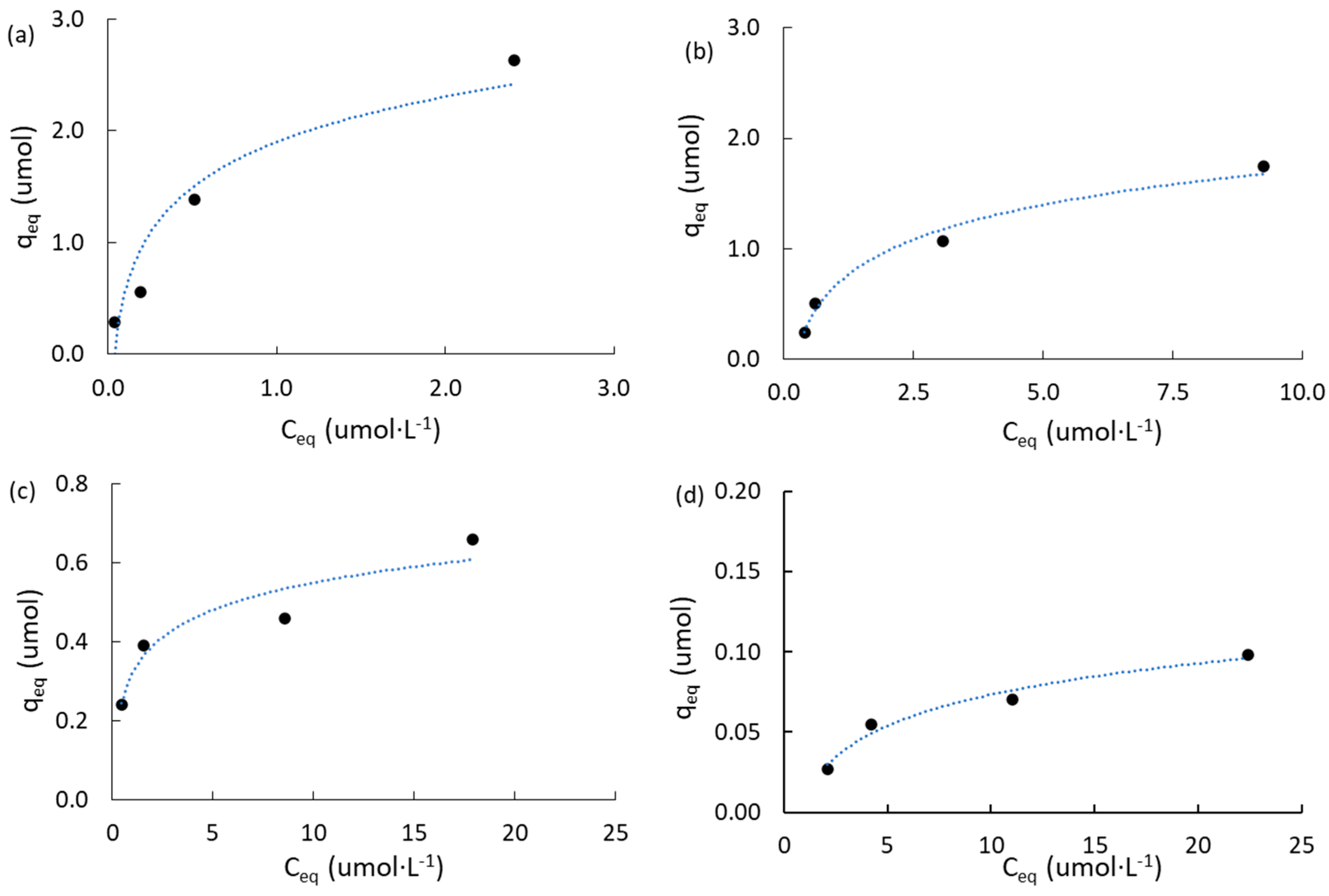
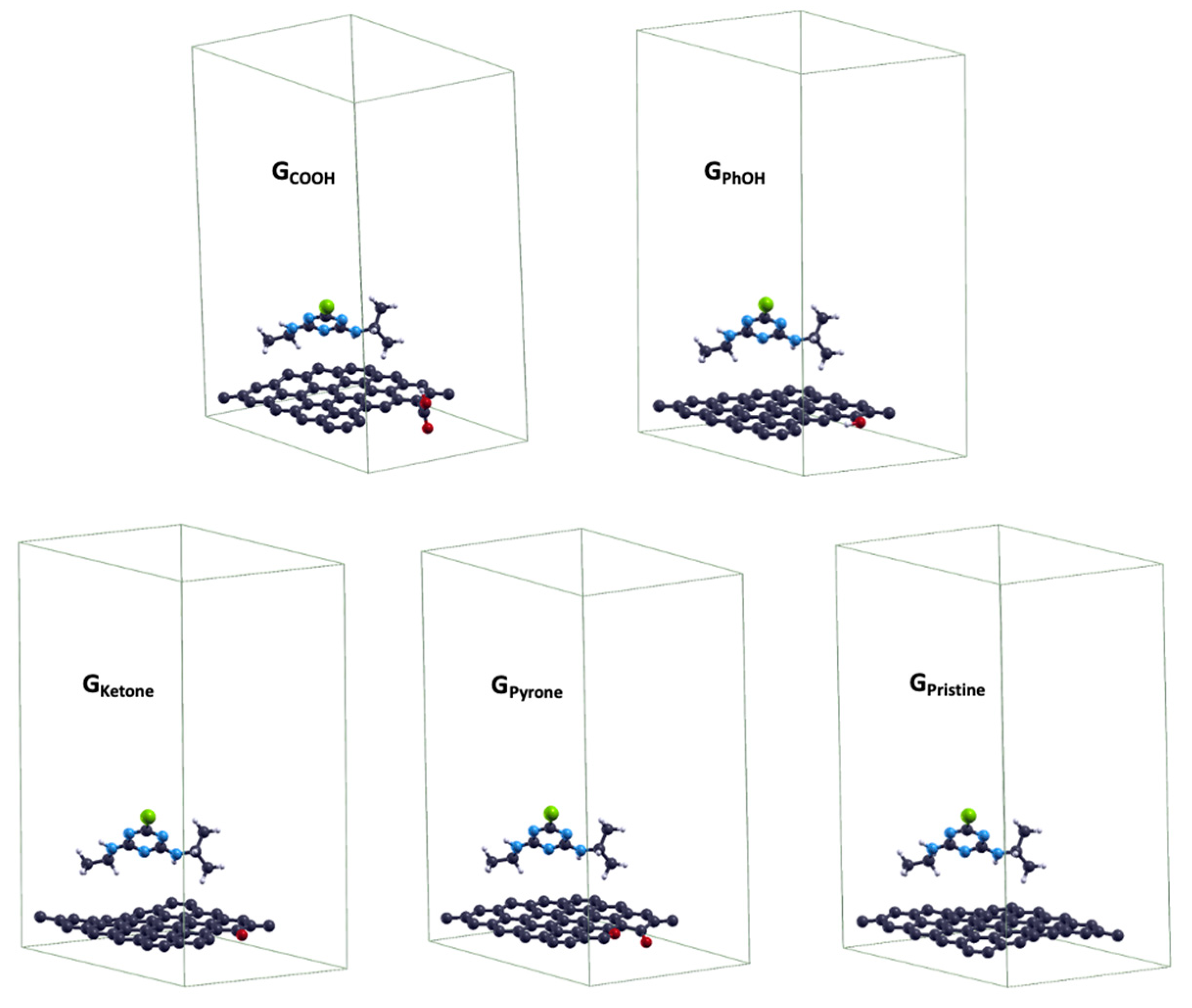
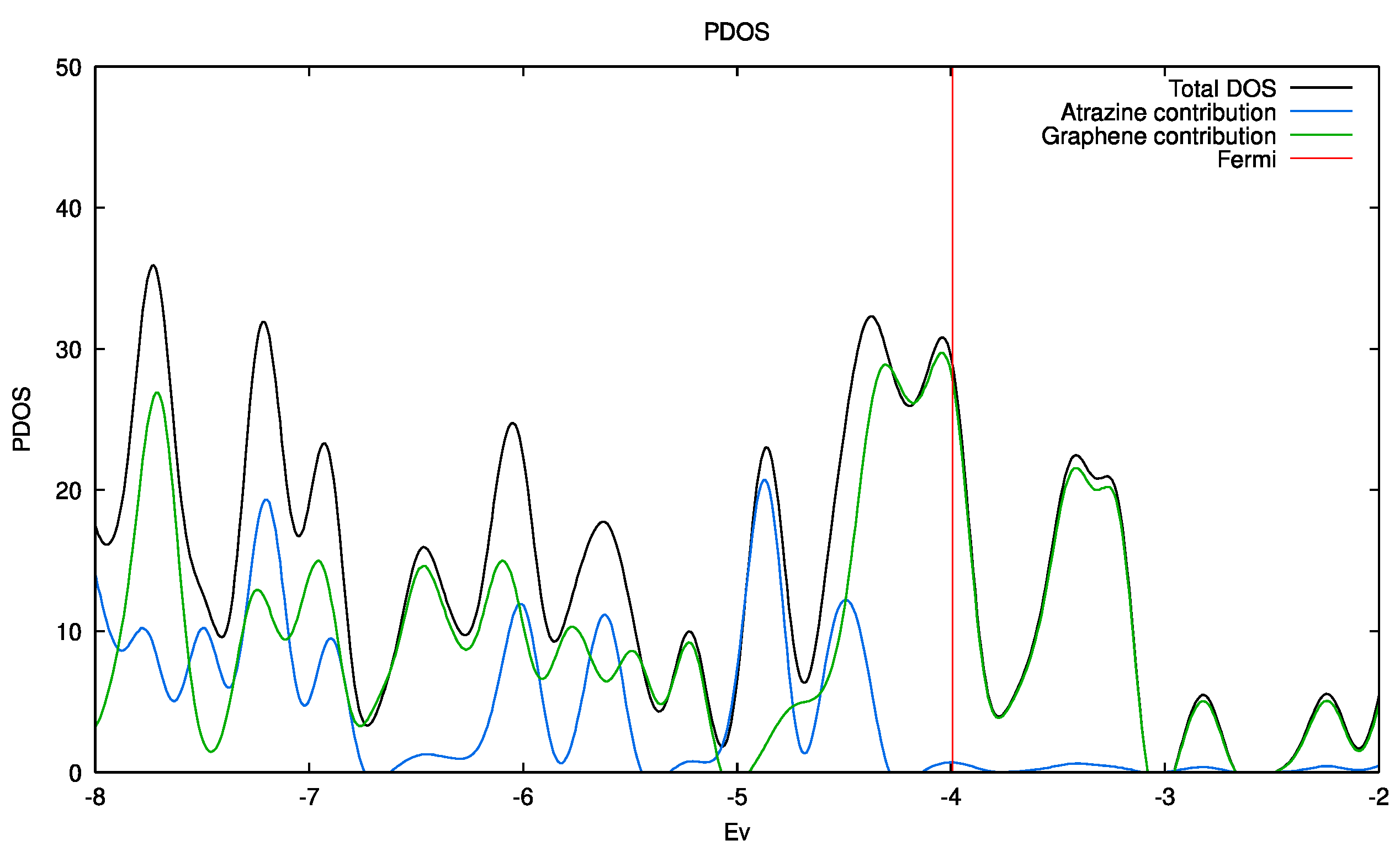
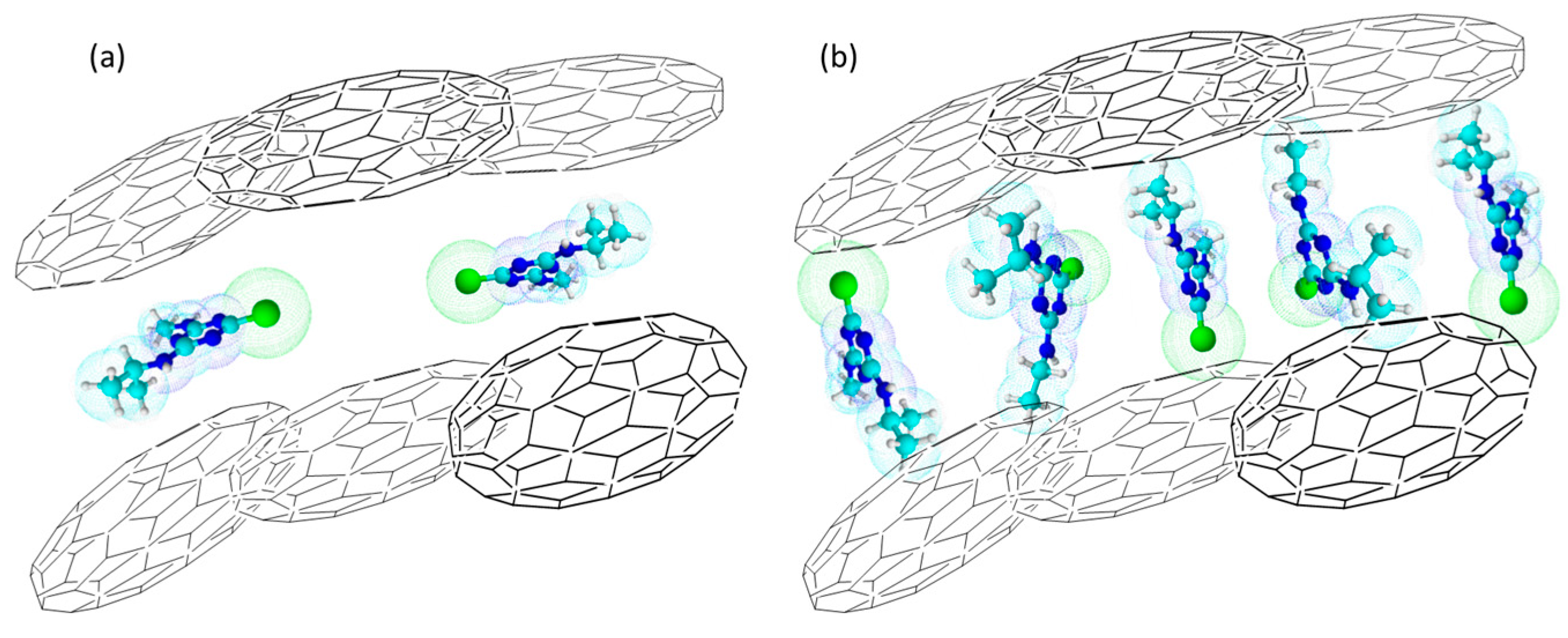
| Samples | Yield a (%) | SBET b (m2·g−1) | Vmic c (cm3·g−1) | W d (nm) | Vtot e (cm3·g−1) | Vmic/Vtot f (%) |
|---|---|---|---|---|---|---|
| MPB | 35 | 20 | 0.001 | -- | 0.030 | 0.03 |
| MPB-CO2 | 24 | 1080 | 0.420 | 0.72 | 0.459 | 0.92 |
| MPB-P50 | 32 | 847 | 0322 | 1.38 | 0.414 | 0.78 |
| ACM g | -- | 775 | 0.402 | 0.96 | 0.495 | 0.81 |
| ACPC g | -- | 1240 | 0.390 | 1.98 | 0.650 | 0.60 |
| Sample | Carboxylic | Lactones | Phenol | Total Acid | Total Basic | Total | pHPZC |
|---|---|---|---|---|---|---|---|
| (mmol·g−1) | (mmol·g−1) | (mmol·g−1) | (mmol·g−1) | (mmol·g−1) | (mmol·g−1) | ||
| MPB-CO2 | 0.053 | 0.532 | 0.360 | 0.413 | 0.532 | 0.945 | 9.7 |
| MPB-P50 | 0.619 | 0.137 | 0.544 | 1.163 | 0.137 | 1.300 | 5.4 |
| Carbon | ATZ (ppm) | qeq a (μmol) | k1 b (min−1) | R2k1 c | k2 d (μmol−1·min−1) | R2k2 e | kp f (μmol−1·min−0.5) | C g (μmol) | R2kp h |
|---|---|---|---|---|---|---|---|---|---|
| ACM | 0.5 | 0.282 | 0.032 | 0.997 | 0.743 | 0.928 | 0.014 | 0.146 | 0.954 |
| 1 | 0.556 | 0.024 | 0.996 | 0.638 | 0.966 | 0.009 | 0.458 | 0.981 | |
| 2.5 | 1.385 | 0.033 | 0.985 | 0.285 | 0.963 | 0.042 | 0.981 | 0.863 | |
| 5 | 2.632 | 0.021 | 0.906 | 0.130 | 0.979 | 0.073 | 1.921 | 0.889 | |
| ACPC | 0.5 | 0.241 | 0.053 | 0.972 | 1.956 | 0.966 | 0.006 | 0.181 | 0.852 |
| 1 | 0.503 | 0.028 | 0.996 | 0.394 | 0.950 | 0.020 | 0.299 | 0.955 | |
| 2.5 | 1.064 | 0.028 | 0.965 | 0.227 | 0.949 | 0.039 | 0.675 | 0.879 | |
| 5 | 1.742 | 0.041 | 0.985 | 0.349 | 0.846 | 0.060 | 1.181 | 0.844 | |
| MPB-CO2 | 0.5 | 0.241 | 0.033 | 0.977 | 0.378 | 0.944 | 0.022 | 0.023 | 0.931 |
| 1 | 0.391 | 0.019 | 0.987 | 0.133 | 0.983 | 0.030 | 0.063 | 0.984 | |
| 2.5 | 0.459 | 0.024 | 0.996 | 0.185 | 0.971 | 0.035 | 0.099 | 0.977 | |
| 5 | 0.658 | 0.026 | 0.980 | 0.124 | 0.980 | 0.046 | 0.189 | 0.963 | |
| MPB-P50 | 0.5 | 0.027 | 0.052 | 0.919 | 18.796 | 0.911 | 0.002 | 0.014 | 0.698 |
| 1 | 0.055 | 0.042 | 0.872 | 8.395 | 0.972 | 0.003 | 0.029 | 0.643 | |
| 2.5 | 0.069 | 0.023 | 0.900 | 2.684 | 0.993 | 0.003 | 0.041 | 0.875 | |
| 5 | 0.101 | 0.035 | 0.919 | 0.818 | 0.992 | 0.006 | 0.035 | 0.958 |
| Carbon | qm a (μmol) | qm a (mmol·g−1) | KL b (L·μmol−1) | R2L c | KF d (mg·g−1) | KF d (mmol·g−1) | nF e | R2F f |
|---|---|---|---|---|---|---|---|---|
| ACM | 1.573 | 0.250 | 5.374 | 0.929 | 134.9 | 0.625 | 1.79 | 0.976 |
| ACPC | 2.937 | 0.466 | 0.246 | 0.934 | 43.2 | 0.200 | 1.72 | 0.942 |
| MPB-CO2 | 0.565 | 0.090 | 1.574 | 0.952 | 15.3 | 0.071 | 4.12 | 0.923 |
| MPB-P50 | 0.139 | 0.022 | 0.120 | 0.964 | 1.59 | 0.007 | 1.99 | 0.921 |
| System | GPhOH | GCOOH | GKetone | GPyrone | GPristine |
|---|---|---|---|---|---|
| Eads-ATZ (eV) | −0.024 | −0.048 | −0.063 | −0.099 | −0.169 |
| µ (D) | 1.103 | 3.290 | 1.917 | 1.791 | 0.001 |
Disclaimer/Publisher’s Note: The statements, opinions and data contained in all publications are solely those of the individual author(s) and contributor(s) and not of MDPI and/or the editor(s). MDPI and/or the editor(s) disclaim responsibility for any injury to people or property resulting from any ideas, methods, instructions or products referred to in the content. |
© 2023 by the authors. Licensee MDPI, Basel, Switzerland. This article is an open access article distributed under the terms and conditions of the Creative Commons Attribution (CC BY) license (https://creativecommons.org/licenses/by/4.0/).
Share and Cite
Matos, J.; Amézquita-Marroquín, C.P.; Lozano, J.D.; Zapata-Rivera, J.; Giraldo, L.; Poon, P.S.; Moreno-Piraján, J.C. Experimental and Theoretical Estimations of Atrazine’s Adsorption in Mangosteen-Peel-Derived Nanoporous Carbons. Molecules 2023, 28, 5268. https://doi.org/10.3390/molecules28135268
Matos J, Amézquita-Marroquín CP, Lozano JD, Zapata-Rivera J, Giraldo L, Poon PS, Moreno-Piraján JC. Experimental and Theoretical Estimations of Atrazine’s Adsorption in Mangosteen-Peel-Derived Nanoporous Carbons. Molecules. 2023; 28(13):5268. https://doi.org/10.3390/molecules28135268
Chicago/Turabian StyleMatos, Juan, Claudia P. Amézquita-Marroquín, Johan D. Lozano, Jhon Zapata-Rivera, Liliana Giraldo, Po S. Poon, and Juan C. Moreno-Piraján. 2023. "Experimental and Theoretical Estimations of Atrazine’s Adsorption in Mangosteen-Peel-Derived Nanoporous Carbons" Molecules 28, no. 13: 5268. https://doi.org/10.3390/molecules28135268
APA StyleMatos, J., Amézquita-Marroquín, C. P., Lozano, J. D., Zapata-Rivera, J., Giraldo, L., Poon, P. S., & Moreno-Piraján, J. C. (2023). Experimental and Theoretical Estimations of Atrazine’s Adsorption in Mangosteen-Peel-Derived Nanoporous Carbons. Molecules, 28(13), 5268. https://doi.org/10.3390/molecules28135268








